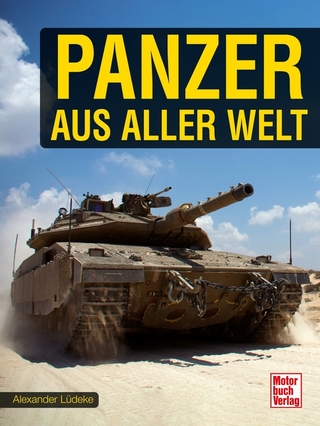
Surviving D-Day Tanks in Normandy
Seiten
2022
Key Publishing Ltd (Verlag)
978-1-913870-23-2 (ISBN)
Key Publishing Ltd (Verlag)
978-1-913870-23-2 (ISBN)
This guide book examines the surviving World War Two tanks, tank turrets and other armoured fighting vehicles currently on display in Normandy, France.
On June 6, 1944, D-Day, the Allied invasion of northern France began. Thousands of Allied soldiers, along with their equipment and vehicles, landed in Normandy on five main beaches. Most tanks arrived on the beaches by landing craft, and a few days later, after the construction of the temporary Mulberry harbor at Arromanches-les-Bains, tanks, along with supply trucks and more troops, started pouring from the ships into the ever-expanding beachhead. This guide book examines the surviving World War Two tanks, tank turrets and other armored fighting vehicles currently on display in Normandy, France, most of which took part in the fighting following the D-Day landings. The background history of each vehicle is explored, and location details are given. Many of the tanks are exhibited in museums, but a number are on display as war memorials, with some being in difficult-to-find places. Also included are the fascinating, little-known stories of the Allied tank attacks on two separate German beach defense fortifications at Gold Beach, both of which survived the initial Air Force bombing and Navy bombardment. They have been preserved and can be visited. 150 illustrations
On June 6, 1944, D-Day, the Allied invasion of northern France began. Thousands of Allied soldiers, along with their equipment and vehicles, landed in Normandy on five main beaches. Most tanks arrived on the beaches by landing craft, and a few days later, after the construction of the temporary Mulberry harbor at Arromanches-les-Bains, tanks, along with supply trucks and more troops, started pouring from the ships into the ever-expanding beachhead. This guide book examines the surviving World War Two tanks, tank turrets and other armored fighting vehicles currently on display in Normandy, France, most of which took part in the fighting following the D-Day landings. The background history of each vehicle is explored, and location details are given. Many of the tanks are exhibited in museums, but a number are on display as war memorials, with some being in difficult-to-find places. Also included are the fascinating, little-known stories of the Allied tank attacks on two separate German beach defense fortifications at Gold Beach, both of which survived the initial Air Force bombing and Navy bombardment. They have been preserved and can be visited. 150 illustrations
Craig Moore is a writer and editor for www.tanks-encyclopedia.com and www.tank-hunter.com, a guide to where you can find surviving WW1 and WW2 tanks. He has had an interest in military history since childhood. Eight of his close relatives fought in both World Wars: only six survived. One of his uncles lost a leg when his Sherman tank was hit during Operation Totalize in Normandy 1944. In 2017 he was part of the team that recovered a buried British WW2 Covenanter tank from a Vineyard in Surry. He lives in London but regularly visits tank museums and archives around the world.
| Erscheinungsdatum | 04.05.2022 |
|---|---|
| Reihe/Serie | Military Vehicles and Artillery Series |
| Zusatzinfo | 150 |
| Sprache | englisch |
| Maße | 170 x 243 mm |
| Themenwelt | Natur / Technik ► Fahrzeuge / Flugzeuge / Schiffe ► Militärfahrzeuge / -flugzeuge / -schiffe |
| Sozialwissenschaften ► Politik / Verwaltung | |
| ISBN-10 | 1-913870-23-5 / 1913870235 |
| ISBN-13 | 978-1-913870-23-2 / 9781913870232 |
| Zustand | Neuware |
| Haben Sie eine Frage zum Produkt? |
Mehr entdecken
aus dem Bereich
aus dem Bereich
von der Machtergreifung bis zur Gründung der Vereinten Nationen
Buch | Softcover (2023)
Motorbuch Verlag
CHF 38,90


